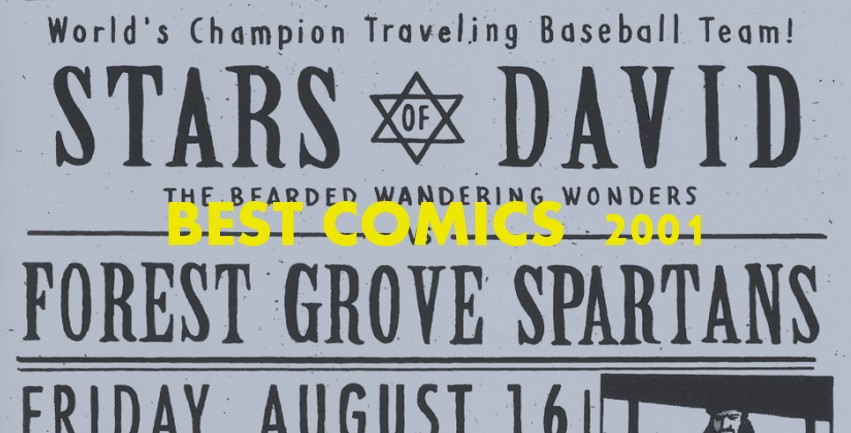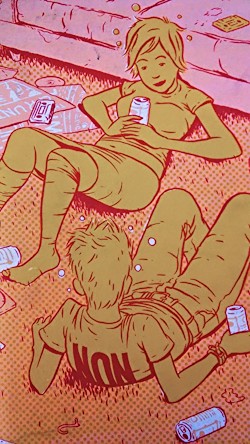“Top 10 Everything 2001”
Por el staff de TIME
Publicado en la formato digital por TIME Magazine, viernes 21 de diciembre de 2001.
– – – – – – – – – –
“The Golem’s Mighty Swing” by James Sturm
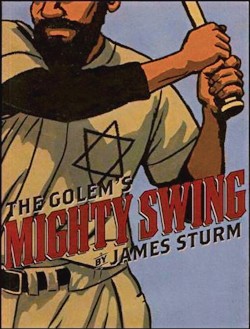
The Great American Sport meets the Great American Artform. Based on the Jewish legend of the Golem, it’s about a barnstorming Jewish baseball team of the 1920s. Astonishingly, the book feels like the best baseball games: a seat-gripping drama made up of little dramas, all of which add up to something greater than just a game. Nostalgic without being saccharine, the art has the look of old baseball cards put together to tell a story. This one book ties together sport, art and literature into a grand-slam comicbook.
“Hey, Wait…” by Jason
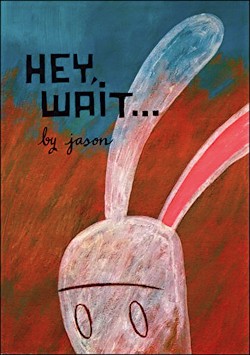
This stunning American solo debut by a mono-named Norwegian creates a cartoony, magic-realist world of animal-headed people who live much like we do, except they might use stilts the way we use cars. Amidst a happy spring of comicbooks and kite-flying, young Jon suffers a tragedy that turns him into an instant adult—careworn and guilt-ridden. Both sad and funny, the book becomes a meditation on how events shape our lives and how complicit we are in letting them do so.
Drawn & Quarterly Vol. 4
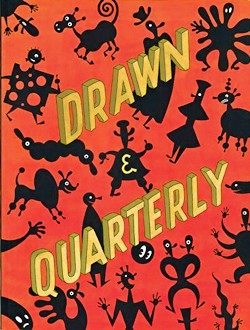
Printed in full color on large-size, heavyweight glossy paper, “D+Q” has become the premium comix anthology series. Appearing annually, this past year’s included a swell mix of European and American works, along with reprints of Frank King’s “Gasoline Alley” Sunday strips from the 1930s.
“Peanuts—The Art of Charles Schulz” edited by Chip Kidd

At once a luxurious monograph of America’s favorite cartoonist, and a radical re-presentation of his work, this book goes way beyond being just another “Peanuts” collection. Almost deconstructionist in design, it includes previously unpublished notebooks with an annotated examination of Schulz’s artwork.
“The Great Women Cartoonists” by Trina Robbins

Not a comic but a much-needed herstory of women comic artists, Robbin’s book also reads like a chronicle of American women’s history as reflected in the comics. Copiously illustrated, many of these artists haven’t been heard of since they last put their pen down.
“All the Wrong Places” by Tom Galambos
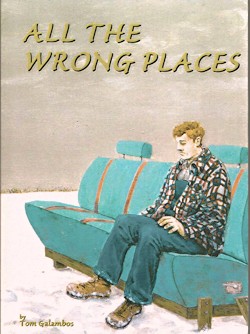
Galambos’ self-published novella has a soft, wistful beauty to it. It’s about a man’s struggle to connect with other people and himself. A comicbook without fistfights, wisecracks, or irony, it manages to pack genuine emotion and quiet contemplation into 76 pages.
Non #5
Gorgeously crafted by publisher Jordan Crane, this anthology is as much a sculpture as a comicbook. The silk-screened cover wraps around the central book, along with two little novellas tucked into a cardboard recess behind it. Brian Biggs, Megan Kelso and about twenty other comix artists contributed to this exceptional collection that could have made this list even without the remarkable packaging.
NOTA: Este comic es uno de los santos griales de principios de siglo. Autopublicado por Jordan Crane, NON solo llegó a 5 tomos entre el ’97 y ‘01, y gracias a un auspicio de la prestigiosa Fundación Xeric ($8,000 dólares, ni más ni menos), Crane logró editar y empacar esta última edición de la manera más lujosa posible.

El reparto de artistas dentro de la edición no tiene parangón: Jason, Mat Brinkman, Dave Kiersch, Greg Cook, Megan Kelso, Ron Regé Jr., Teven Weisman, Paul Lyons, James Kochalka, Paul Pope, Nick Bertozzi, Brian Chippendale, Chris “Pshaw” Cammett, Brian Biggs, Tom Devlin, Brian Ralph, Ulf K., David Choe, Kurt Wolfgang y el propio Crane.
NON #5 incluye aparte de la Antología principal dos novelas gráficas, “Col Dee” (por Crane, Red Ink) y “Where Hats Go” (por Wolfgang, Bertrand Island Press).
“Pistolwhip” by Jason Hall and Matt Kindt

With the kind of boldness born of inexperience Hall and Kindt published their first comix as a full graphic novel, and threw in a second, shorter comic as well. Using the tropes of film noir (private detectives, femme fatales) with a fresh, almost goofball expressionism, these guys more than justified their self-confidence.
“Jack Cole and Plastic Man” by Art Spiegelman and Chip Kidd
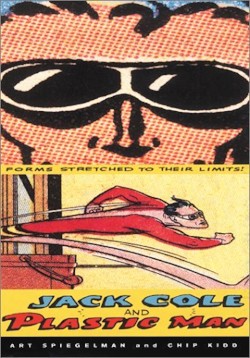
Originally appearing in the “New Yorker,” Spiegelman’s essay on the life and art of Jack Cole has been expanded in book format with tons of Cole’s work. Designed by Kidd, you couldn’t imagine a more playful book about the too-short life of Plastic Man’s creator.
“Heavy Liquid” by Paul Pope

After several works of stylish but hard to follow sci-fi, Pope gets it dead on with this smart, offbeat story about a weird liquid with psychotropic properties. For those who yearn for comix’ very own version of “Blade Runner” or “The Matrix,” your prayer has been answered.
